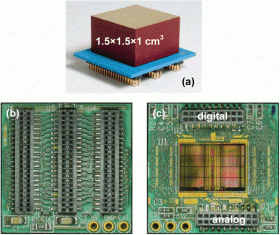Technologies Available for License
Category: electronics & instrumentation
2007-016: Sensing 3-D Interaction Positions in Semiconductor Radiation Detectors
Invention: 2007-016
Patent Status: U.S. Patent Number 8,269,180 was issued on September 18, 2012
For technical and licensing related questions, email tcp@bnl.gov.
Summary

Sample of (a) 121-anode CZT sensor; (b) back view and (c) front view of ASIC.
This device determines the three-dimensional depth of ionizing interactions within a radiation sensor. A cathode charge amplifier connects to a timing shaper within the device that produces dual pulses associated with the ionization location. A timing shaper connected to a charge amplifier receives two cathode signals for each event and then pinpoints the radiation within a detector.
Description
The readout unit is configured to receive a cathode signal in response to an ionizing event and to generate a bipolar shaped cathode signal. This shape represents a first pulse corresponding to a first change in slope of the cathode signal and a second pulse corresponding to a second change in slope. The readout unit determines the amount of time between the peak of the first pulse and the peak of the second, which then translates into the depth of interaction. 3-D position-sensitive ionizing radiation high-Z semiconductor detectors combine pixilation of an anode electrode with measurement of amplitude and timing. This information is used to reconstruct the ionizing interaction location, and to correct the measurement on a voxel-by-voxel basis.
Benefits
With this approach, energy resolutions better than 1 % FWHM at 662 keV in CZT have been achieved, limited by the resolution of readout electronics. Employing the 3D correction method also allows for the use of lower grade and larger size detectors. The readout unit for 3D position-sensitive radiation detectors has low-noise charge amplification and filtering that measures amplitude and timing on signals from a cathode, anode, or an anode grid.
Applications and Industries
Semiconductor radiation detectors are useful in a large variety of fields, including nuclear physics, x-ray and gamma ray astronomy, medical imaging, nuclear nonproliferation, non-destructive detection, radiation imaging, and homeland security. Their imaging capabilities, good energy resolution, and the ability to fabricate compact systems are very attractive features compared to other types of detectors, such as gas detectors and scintillators.
Journal Publication & Intellectual Property
Contacts
-

Poornima Upadhya
Manager Technology Transfer & Commercialization
Technology Commercialization
(631) 344-4711, pupadhya@bnl.gov
-

Avijit Sen
IP Licensing & Commercialization
Technology Commercialization
(631) 344-3752, asen@bnl.gov




